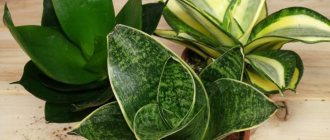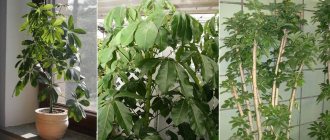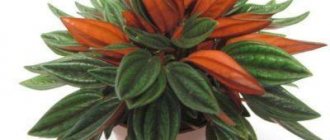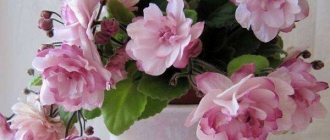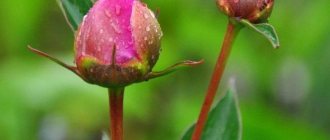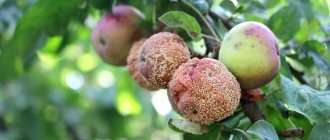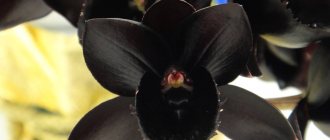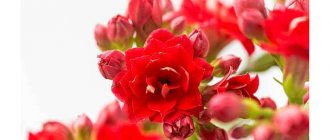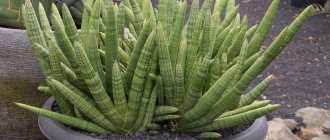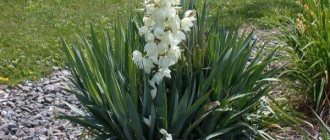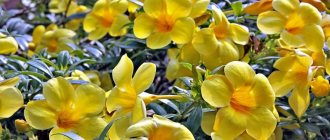The Sansevieria genus includes 60 species of perennial, stemless succulents and foliage plants, distributed in areas of Africa, Madagascar, India, South Florida and Indonesia.
Succulents with hard and tough foliage grow in hot, arid desert climates, while deciduous varieties come from tropical and subtropical regions.
The genus name is given in honor of the Italian scientist and inventor Raimondo di Sangro (1710-1771), Prince of Sanseviero, who brought the succulent from Africa to Naples in the 18th century. Since then, the flower has gained immense popularity in Europe.
Sansevieria is an ideal indoor flower that combines decorativeness and absolute unpretentiousness in home care.
Description
Sansevieria moonshine (sansevieria) has the Latin name Moonshine and belongs to the Agave family. Moonshine – translated as “silver moon” , this description corresponds to the color of the leaves of this flower. Among gardeners, the plant is also called “pike tail” (a collective name for all types of sansevieria) or “snake skin”. You can learn more about Sansevieria species here.
Moonshine is a perennial, evergreen plant. Its leaves are dense, erect, and pale green in color. A distinctive feature is a bluish-silver tint. The stem is missing. The leaves appear immediately from the rosette, curl at its base and tend upward. Their width reaches 5-6 cm, and their height is about 30 cm. The flowers are white, collected in miniature panicles. The diameter of the rosette rarely exceeds 12 cm, and the height is 35 cm.
Reference! The habitat of wild Sansevieria Moonshine is the subtropical zones of Africa, India and Madagascar.
Sansevieria propagation
If the time to plant mother-in-law's tongue was in the spring, you can combine this procedure with propagation. During this period, all biological processes are proceeding at an accelerated pace; the active movement of juices will help the plant take root faster.
Novice gardeners are interested in the question of how Sansevieria reproduces. This activity is carried out in several ways:
- division of rhizomes;
- cutting off side shoots;
- fragments of a leaf plate.
The latter option does not allow preserving the color of some types of pike tail, but the method still remains popular. This method is especially good if the root system has become sick and unusable.
Preparing for transplant
Leaf
You can also use the propagation of Sansevieria by leaf in the case when an already formed plate breaks off. At the same time, mother-in-law’s tongue can be rooted both in the soil and in a cylindrical container with water.
The soil
In order for Sansevieria to take root, propagation by leaf is carried out in a soil other than that intended for replanting the flower. In this case, the loose substrate should contain components in the following proportion:
- 1 part of sand and humus;
- 2 parts each of turf and leaf soil;
- The presence of charcoal is required.
Another composition is also suitable for propagation: from leaf and turf soil with the addition of perlite (all ingredients are taken in equal parts). The soil must be sterile (calcined) and moist before planting.
What kind of pot do you need?
The rules for choosing a container for a pike tail were mentioned above. The cuttings with which the plant will be propagated are small in size. Therefore, you should not take a spacious pot. For starters, a container no more than 8 cm in diameter and about 5-6 cm deep is quite suitable.
As for the material of the pot, it must be breathable so that future roots can breathe. Ceramics (clay) are best suited for this. In addition, it perfectly absorbs water, acting as additional drainage.
Agricultural technology
To know how to properly propagate sansevieria by leaf, follow the step-by-step instructions. At the same time, despite the general aspects, there are differences in earth and water rooting.
Leaf propagation
First perform the following actions:
cut a healthy, undamaged leaf from the mother bush; the plate is cut into strips of 10-15 cm, moving with a sharp knife perpendicular to the veins; On each fragment, the bottom and top are marked with a marker (this is important when planting).
Important! If part of the plate is buried in the ground or lowered into water with the wrong cut (against the flow of juices), you may not expect roots. Peculiarities of propagation of Sansevieria by leaf
Peculiarities of propagation of Sansevieria by leaf
| In the ground | In water |
|
|
Planting leaf parts directly into the substrate is preferable - rooting will occur faster (in 1.5-2 months). New shoots from the leaf can be expected in 7-8 months. For this to happen, optimal conditions are maintained:
- air temperature – within 21-25°;
- luminous flux - only diffused;
- substrate – moderately moistened (watering through a tray).
Note! When propagated by leaves of mother-in-law's tongue, some gardeners practice the greenhouse effect. It is undesirable to do this - due to high humidity, the cuttings may rot
Why remove the growing point of Sansevieria?
The goal of propagation is not just to get a new plant, but also to preserve all its characteristics. Not every method satisfies this desire. In varieties with variegated leaves, color can only be preserved by propagation by layering.
The older the plant, the less likely it is to get planting material from it. After 5 years, the flower practically does not form root layers. To stimulate the queen cell to develop, you need to carefully cut out (not twist) the growth point and remove the top 2-3 leaves.
Sansevieria with layerings
The plant will immediately redirect its forces to the development of the rhizome; after 1.5 months, several good layering will develop on the bush. They are cut off and planted in pots. After this, an adult Sansevieria can grow for several more years (until the foliage dies).
Photo
Below you can see a photo of the plant:
What kind of soil does sansevieria need?
The plant does not like acidic soils - the skin on the flower cracks due to the high nitrogen content. The best option is soil with a neutral pH (6-7). The loose, light structure provides good aeration to the roots.
Sansevieria
The substrate for transplanting sansevieria is prepared according to the following recipe:
- add the same amount of sand to the 1st part of peat;
- add 3 parts of turf or leaf soil, as well as ½ part of humus;
- add a little vermiculite or perlite to the mixture (to absorb excess moisture);
- the substrate is poured into a pot and used to transplant the flower.
You can also take a different soil composition: from sand, deciduous and turf soil in a ratio of 2:2:6, respectively.
How to care at home?
Sansevieria Moonshine is unpretentious and does not require special attention or special conditions for growing. In order for the leaves to be dense and not lose their characteristic color, you must adhere to the following care rules.
Temperature
Sansevieria is unpretentious to temperature increases; it grows well in the range from +18 to + 35°C. But when it drops below +15 °C, the plant will first lose its characteristic color, and then may even die.
Watering
The main condition is regularity, without excessive drying out or waterlogging of the soil.
During the winter months, the frequency of watering is reduced as the temperature drops , down to an interval of 2-3 weeks. In summer, the frequency reaches 1-2 times a week.
The water should be settled and at room temperature. In all seasons, the foliage must be wiped with a damp sponge at least once a week, avoiding moisture getting into the outlet.
Light mode
Sansevieria prefers a well-lit place , without direct sunlight. Summer afternoon sun can leave burns on its leaves.
Attention! With insufficient lighting, plants slow down and the leaves become dark green without a bluish tint.
Priming
For planting, universal soil is suitable, additionally enriched with loosening components:
- perlite;
- pebbles;
- fine expanded clay.
To make your own soil you will need:
- leaf soil - 1 part;
- sand – 1 part;
- turf soil - 2 parts.
Pot
Sansevieria is very elongated, so for stability it will need a low but wide pot. Its diameter should be approximately twice the height. The powerful roots of Sansevieria can easily deform or even break a thin plastic pot. Preference should be given to thick-walled ceramic options.
Transfer
Due to its slow growth, the plant does not require frequent replanting . A sign of its need is the appearance of roots from the drainage holes at the bottom of the pot.
The optimal time for the procedure is late spring-early summer.
Step-by-step instructions for transplanting Sansevieria:
- Pour at least 1.5-2 cm of drainage into the bottom of the new pot. Its role can be small pebbles or expanded clay.
- Pour soil on top, the thickness of the layer depends on the height of the pot (but not less than 2 cm).
- Place the flower and distribute the root system throughout the pot.
- Fill with soil to the edge of the pot. Press lightly with your hand and pour generously.
Fertilizing
Mineral fertilizers for indoor plants or succulents are suitable for Sansevieria Moonshine . It is more convenient to use fertilizer in liquid form. The application period is from March to September. Before use, the fertilizer must be diluted twice as much as indicated in the instructions. Fertilize no more than once every two weeks.
Trimming
To perform pruning, you only need well-sharpened scissors. Execution algorithm:
- Remove all yellowed, rotted or dried leaves.
- Trim the dried ends, not retreating more than 1 cm from the edge of the sheet.
- Treat the cuts with crushed coal.
Important! Pruning is performed only to remove dried foliage; the plant does not need shaping.
Wintering
In anticipation of the winter months, it is necessary to gradually reduce watering to once every 2-3 weeks. The temperature should not drop below +15 °C; prolonged exposure to open windows or vents should be avoided. To preserve the color of Sansevieria Moonshine, additional lighting is required during the winter months.
Features of reproduction
You can get a young plant in two ways:
- By dividing the rhizome .
In spring, remove the mother plant from the pot and divide its rhizome into several parts. Each of them must have at least one growth point. Plant in new pots, place in a warm place and water moderately. Rooting time is 1-1.5 months. - Side shoots . During transplantation, separate the already formed young shoots and plant them in new containers. It will also take about a month for complete rooting.
Important! When using the leaf propagation method, loss of the decorative qualities of the plant, in particular the color of the shoots, is possible. Therefore, preference should be given to dividing the rhizome and side shoots.
Popular types:
Sansevieria 'Almond Silver'
If you are looking for a plant that is persistent, unpretentious, but capable of intriguing and standing out, Sansevieria “Silver Almond” is just for you! The plant has strong, hard, branched leaves up to 40-45 cm in length. When we look at a plant in profile, its appearance may evoke associations with a fan. The leaf blades are massive, very fleshy and hard. Unusual shaped sockets. The edges of the leaves are distinguished by a delicate notch and silvery color. The surface of the leaf blades is muted, gray-green or olive in color. “Almond Silver” is a rare, but extremely interesting and amazing variety of Sansevieria.
Sansevieria 'Amazon Green' - spiral (Sansevieria 'Amazon Green')
An interesting succulent in a minimalist style. Its long, narrow leaves taper upward and end at the top with long, sharp tips. The edges of the leaf blades are decorated with a delicate, invisible light green border. This elegant accessory beautifully emphasizes his unique, familiar look. Rigid, symmetrical rosettes form a majestic, regular plume of whorled leaves that flow smoothly outward.
The undoubted advantage of this plant is its dense foliage of an elegant, rich green color. Sansevieria "Amazon Green" will perfectly complement the collection, and will also look great in all interiors and will be a wonderful contrast to more muted colors.
Sansevieria 'Black Gold'
Interesting succulent with amazing foliage. At home, it can reach 100–150 cm in height and 25–50 cm in width. Exotic dimensions make the plant an excellent choice when decorating modern interiors. Sansevieria produces fleshy, sword-shaped, pointed leaves with sharp edges. The dark green color of the slightly wavy leaf is emphasized by lush yellow edges. “Black Gold” is a rare variety for sale, and therefore very valuable and in demand. The intensity of leaf color and the resulting contrasts largely depend on growing conditions.
Sansevieria 'Comet Pixel'
An interesting variety with a silver-green color and a rosette, but slightly disheveled. The leaves are medium wide, groove-shaped, and decorated with an interesting pattern. Despite the differences in the design, vertical thin green lines are clearly visible on all sheets. The youngest leaves are lighter, steel green with clearly defined vertical lines. Uneven dark green stripes gently penetrate here and there. As it matures, more and more dark green color appears, and dark green transverse veins are already visible on older leaves.
Sansevieria 'Greenline'
Produces an erect, tall clump of narrow, long, sword-shaped leaves growing side by side. The surface of the leaves is decorated with magnificent dark green transverse variegated stripes. Sansevieria Greenline is an excellent choice for those looking for plants that are unpretentious, resilient, yet attractive and elegant. It looks great in both modern and classic interiors, adding a touch of exoticism.
Sansevieria bacularis Mikado (Sansevieria 'Fernwood Mikado')
An excellent variety that grows to a maximum height of about 70 cm. It has raised cylindrical, not too thick pointed leaves. The surface of the leaf blade is dark green, decorated with light green transverse stripes. The leaves grow straight from the ground, one next to the other, forming beautiful prickly clumps. This variety is valued for its beautiful color, interesting appearance and low requirements.
Sansevieria 'Queen Marble'
A distinctive succulent with interesting colors. The rosettes of leaves have a rigid shape, reminiscent of the foliage of a pineapple fruit. Its leaves are massive, fleshy and densely spaced. The alternation of dark and light green perpendicular stripes gives them an original color. The color scheme changes slightly with the phase of their development. Young leaves growing from the center have a bright green color, and as they mature, their shade becomes highly saturated. Thus, the transverse stripes turn into dark green irregular stripes and contrast beautifully with the light green of the rest of the leaf blades. Additionally, they emphasize the bright color of the youngest leaves that are just blooming. 'Queen Marble' has dense foliage that looks great on a shelf or windowsill.
Sansevieria 'Silver Nymph'
An interesting variety that, in combination with other sansevieria, has an extremely intriguing appearance. "Silver Nymph" has narrow, long, hard, pointed leaves. The silvery, light green surface of the leaf blades is decorated with transversely located abrasions of a dark green hue. The plant forms spectacular rosettes with an erect habit. Its leaves grow from a single shoot and spread widely at the top. This way they create an interesting, slightly ruffled shape. Sansevieria “Silver Nymph” is an elegant and original interior decoration, the great advantage of which is its low growing requirements and high stability.
Sansevieria 'Star Iguana'
An excellent low variety with a calm color, without clear stripes or patterns on the leaves. It is characterized by a clear predominance of green color on the leaf blades and a slightly yellowish, finely porous middle of the leaf. Despite the clear predominance of green, the presence of lighter and more subtle color changes creates a beautiful and light shading on the leaf blade - lighter in the center and darker at the edges. The wide leaves taper upward, pointed, and form a rosette. The edges of the leaves are decorated with a thin, lighter border, ideally emphasizing the wide shape of the leaf. This is an excellent offering for Sansevieria collectors who appreciate the variety of details that distinguish the Star Iguana from other varieties of the species.
Sansevieria 'Tiara Grand Gazelle'
A very interesting variety, recommended for fans of Sansevieria and those who want to decorate the interior with a spectacular and at the same time unpretentious plant. It attracts attention with its original fan-shaped shape. The leaves lie tightly to the ground, they grow alternately - now to the right, now to the left, and diverge at the same distance from each other. In addition to the original and orderly shape of the whole plant, the green, long, narrow, grooved and pointed leaves are undoubtedly a decoration. Despite the muted colors, darker vertical lines and striations are clearly visible on the leaves.
Sansevieria 'Tough Lady'
A charming succulent with an interesting green color. Its leaves grow in layers, forming a beautiful harmonious rosette with a vertical, majestic silhouette. The green leaf blades are varied with darker green spots directed perpendicular to the edge. Young pointed leaves grow from the center and fly up. As they grow, they gradually take on a deeper shade of green. As a result, the rosette, seen from the side, displays the fullness of its charm, showing an interweaving of dark green and silvery shades of green.
Sansevieria aubrytiana 'Dragon'
The most striking decoration of the “Dragon” is the fantastic sword-shaped leaves with a characteristic spotted pattern. Sansevieria "Dragon" has rather wide and pointed leaves that smoothly curl in a spiral. Although the leaves grow close together and are raised upward, the plant takes on a somewhat chaotic appearance as some of the leaves bend slightly in different directions.
However, the most attractive is the mottled bright silver-green pattern across the entire surface of the leaf blade. The spots are mostly irregular, but densely punctate, contrasting very clearly with the dark green leaves. Sansevieria "Dragon" is an excellent choice for those who are looking for unpretentious, persistent, but at the same time attractive and elegant plants. Looks great in both modern and classic interiors.
Guinea Sansevieria 'Laurentii' (Sansevieria 'Laurentii')
A very interesting leaf succulent. It tolerates harsh living conditions very well, is undemanding and easy to grow. Planted in a beautiful pot, it will look great and be an elegant decoration for both modern minimalist interiors and traditional apartments. The species originates from equatorial Africa, hence its exotic beauty, low requirements and high resistance. It grows to approximately 100-150 cm in height and produces thick, stiff, raised, sword-shaped leaves that fit tightly together.
The dark green surface of the leaf blade with a golden border is additionally decorated with irregular transverse gray-green stripes. The plant blooms in early summer. Then small white-cream flowers appear, located on a long stem. They are not very decorative, but they exude a pleasant, strong, sweetish aroma.
Sansevieria 'Black Superba' (Sansevieria Black Superba)
An elegant variety characterized by beautiful patterned foliage. Sansevieria Black Superba is a less common, close relative of the popular Sansevieria Futura Superba. However, its leaves are darker, due to which the contrast of the green surface in combination with the yellow border is more emphasized. The visual effect is further enhanced by irregular striped abrasions in a creamy green color. Its long, broad, gently curled, stiff, sword-shaped leaves with sharp tips form attractive, compact, upright tufts. It looks great in both modern and classic interiors, adding an exotic atmosphere to them.
Sansevieria trifasciata 'Golden Flame'
A phenomenal, rare and hard-to-find variety, captivating with its rich contrasting color. It has hard, rather wide leaves with a beautiful glossy surface. The center of the rosette is yellow and the outer leaves are dark green with yellow accents. Sansevieria 'Golden Flame' produces wonderful two-colored clumps reaching approximately 45cm in height. Young leaves are bright yellow, while older leaves are dark green.
Interesting, expressive colors make the Golden Flame variety an original, modern interior decoration. The plant looks very elegant, is also easy to grow and is extremely resistant to lack of water and light. This is a valuable collectible variety that is difficult to obtain and is found in limited quantities.
Sansevieria metallica 'Silver Siam'
A unique and rare variety of Sansevieria with a beautiful unusual color. Sansevieria metallica 'Silver Siam' grows to approximately 60cm in height. Its decoration is long, hard, sword-shaped leaves. The surface of the leaf blade is green-gray, additionally decorated with vertical irregular blurry stripes of creamy white color. Decorative, erect leaves grow close together to form attractive compact clumps.
During flowering, the plant produces beautiful tiny white flowers located on a straight, thick stem. In addition to the unusual coloring, the big advantage of this unusual variety is its low cultivation requirement and high resistance to lack of water and light.
Guinea Sansevieria HAHNII 'Golden Blue' (Sansevieria HAHNII 'Golden Blue')
Sister of the popular Golden Hahnii variety, which is characterized by a clear predominance of blue on the leaf blades and a less creamy edge. Like her cousin, she has a small target size and a slow growth rate. The rounded leaves taper upward and end with sharp tips. The edges are decorated with an irregular gold border, which perfectly emphasizes the broad shape of the leaves, and also contrasts with the blue and green color of the central part. The leaf blade has a pastel blue color, which is varied by irregular silver stripes located perpendicular to the edge.
Sansevieria fisherii
An exceptional species, surprisingly variable as it grows. The juvenile form has short, stiff leaves with recurved grooves and arched leaves. They fold out to the sides to form a compact socket. Older plants have taller and more tightly curled leaves. Mature plants grow more upright and lose their rosette shape.
In addition to its interesting and varied growth habit, Sansevieria fischeri impresses with its attractive leaf colors, ranging from gray to brown-green with lighter transverse striped patterns. The edges of the leaves are indicated by a brown border. It grows naturally in Kenya, Tanzania, Ethiopia and Somalia in sunny locations with well-drained soil.
Sansevieria cylindrica 'Tiara Emerald'
A beautiful potted plant with a characteristic regular fan-shaped shape. The plant has no distinct stem and its thick, cylindrical and blunt leaves lie tightly to the ground. The undoubted decorative value of Sansevieria 'Tiara Emerald', in addition to the characteristic fan-shaped and cylindrical shape of the leaves, is also the amazing dark green, even emerald color of the leaves. There are no clear patterns or spots on them, only subtle lighter spots appear here and there.
Palatally diverging rosettes are rigidly embedded in the substrate, grow slowly and do not lose their typical fan shape. Over time, children's sockets appear next to the main outlet.
Sansevieria cylindrica 'Lady Charm'
A new interesting variety of sacevieria, cylindrical in shape with clear, thick strokes. Its vertically arranged leaves are thick and round in cross section. The olive green color is interspersed with darker patterns running across the axis of the leaf blades. Numerous green stripes are densely spaced, and their lines are irregular and wavy. It seems that they were made with neat brush strokes.
The pointed leaves grow rigidly upward, turning slightly to the sides at the apical part. They end up creating lush, dense, lumpy shapes. 'Lady Charm' is unlikely to reach its large target size and will grow slowly, like most trumpet sansevierias. An attractive variety that will complement the design of modern and classic interiors. Another interesting proposal to complement the collection for sansevieria collectors.
Sanseveria 'Boncel' (Sansevieria cylindrica 'Boncel')
Sanseveria 'Boncel' produces a very distinctive regular fan shape. Thick, cylindrical leaves are obtuse. They do not have petioles or other parts typical of popular houseplants. The plant also does not have a distinct stem. Its silvery-green leaves lie tightly to the ground, forming a rigid rosette.
The ornament is not only a characteristic shape, but also transverse green whorls distributed along the entire length of the cylindrical leaves and a delicate shine on their hard skin. Palm-shaped rosettes are firmly embedded in the substrate, growing slowly by elongation and expansion, but without losing the typical fan shape. Over time, children's sockets appear in parallel at the main outlet.
Sansevieria 'Boncel' is a very elegant and original houseplant with low requirements. It combines an attractive, interesting shape with high resistance to lack of water and lack of light.
Sansevieria trifasciata 'Fire'
The first association that comes to mind when looking at Sanseveria 'Fire' is a fiery flame. Thanks to the shape and pattern of the leaves, it is extremely impressive, and in a properly selected pot it will certainly become an original and spirited interior decoration. It owes its vibrant and fiery beauty to its extremely interesting leaves.
The extremely broad, leathery and shiny leaves are dark green in the center and their edges are marked with a broad yellow-gold border. In some places, green vertical lingual stripes appear on the yellow edge, resembling thin flames. Additionally, the leaves of Sansevieria fiery are neatly twisted and end sharply, which, together with the pattern on the leaf, creates an association with a burning fire. It grows tall and quite compact.
Diseases and pests
The main pests of this variety are:
- Spider mite . The leaves turn yellow and white spots appear on them. For prevention, wiping with a damp sponge is used; for treatment, the insectoacaricide Actellik is used.
- Thrips . The leaf blade becomes grayish-brown, and eggs laid by the pest are visible on the underside. Insecticides are used for treatment.
- Mealybug . The foliage becomes distorted, turns yellow and dies. If the pest colony is small, it can be removed by wiping the leaves with a damp cloth. In case of severe damage, karbofos is used.
The most common diseases and care errors are:
- Brown spots and dried areas are symptoms of anthracnose. The disease develops due to waterlogging and is treated with a fungicide solution.
- Yellowness and softening of the leaves at the base is another sign of waterlogging. All affected shoots must be removed and the plant transplanted into fresh soil.
- Uniformly withered leaves and their death may indicate an excessive drop in temperature and dry soil. Sansevieria must be moved to a warm place and all damaged areas removed.
Varietal diversity
After the main subspecies was developed through selection, several other varieties were obtained. Their differences lie in the color of the leaf plates.
- Sansevieria Hanni Cristata retains its characteristic pockmarked coloration. But the leaf plates are wrapped on both sides towards the center, almost folding in half.
- Sansevieria Honey Gold is one of the most popular varieties. A variegated form that stands out among other varieties with longitudinal stripes of a golden hue. In Sansevieria Hanni Golden, the colored strokes are located unevenly, which only adds to its decorativeness along with the yellow border.
- Silver Hunny differs from the main variety in the color of its leaf blades. Instead of green, silvery-gray shades are expressed. The transverse stripes are clearly visible.
- Sansevieria Hanni Lucille Polan is similar to the Golden variety: it also has wide longitudinal stripes of a yellowish color, only a little lighter. In addition, the leaf plates are rolled inward a little more, giving a boat shape.
Similar flowers
Other representatives of this genus are most similar to Sansevieria Moonshine:
- Cylindrical.
- Futura.
- Bacularis.
- Black Coral.
- Laurenti.
Did you know that sansevieria purify indoor air from toxic substances such as formaldehyde and nitric oxide? To successfully grow this flower, we recommend reading our articles about three-strip, Velvet touch and Hanny.
Sansevieria Moonshine is a beautiful and unpretentious houseplant that is suitable not only for beginner gardeners, but will also add to the collection of experienced indoor plant lovers.
Landing
Aloe vera flower: description, features of care and cultivation, medicinal properties, photo
Ceramic container, wide and shallow, drainage hole
A drainage layer must be placed at the bottom of the planting container: small pebbles, expanded clay, broken bricks with pieces of charcoal. This layer should be thicker the younger the plant and can fill up to a third of the volume of the pot.
When planting, pay special attention to the preservation of the root system, trying to preserve the earthen ball. Transfer
Transfer
Sansevieria hanni are replanted in the spring, in March-April. The signal for replanting is the complete entanglement of the soil with roots. Young plants give such a “signal” annually, more mature ones – once every 2-3 years.
Before transplanting, stop watering, plant in moist soil, and do not water immediately after transplanting.
In summer, it is enough to water Sansevieria hanni once a week, and in winter - once a month. This is exactly the case when it is better to dry it than to over-moisten it.
Deciduous plants are especially protected from the ingress of irrigation water: stagnation of moisture in it leads to root rot, which will destroy the plant.
Dry air is preferable; spraying is not necessary; you just need to periodically wipe off the dust from the leaves.
Top dressing
During the period of active growth of sansevieria, in spring and summer, fertilizing is carried out once every two weeks with a specialized mixture for cacti and succulents.
If complex fertilizers are used, you need to take into account that they should not contain an excess of nitrogen compounds and this complex must be dissolved in a much larger amount of water than for other plants.
Trimming
This operation is applied only to damaged leaves. They usually dry out and then such an area should be cut off, leaving a narrow dry border so that the process stops.
Bloom
Sansevieria hanni can bloom at any time of the year - with small star-shaped flowers on an elegant peduncle. This peduncle needs to be trimmed after flowering.
To encourage the plant to flower, it is transplanted into a tight pot, only 4-5 cm wider than the previous one.
Transfer
A plant purchased at a flower shop is placed in a shaded place for 2 weeks to adapt. Then the sansevieria is transplanted as follows:
- Take a pot slightly larger in volume than the previous one.
- Pour drainage into the bottom and fill one third with soil.
- Carefully shake the bush out of the old container, and trim the dried roots if necessary.
- Place a flower in the middle of the pot and cover it up to the root neck with soil.
- The substrate is lightly compacted and watered.
Excess water is poured out of the pan. Sansevieria is placed in a shaded room for 3-5 days, then placed in a permanent place.
Pike tail bloom
The ability of the pike tail to flower depends on compliance with the recommended care rules. The buds are not particularly beautiful, but they fill the room with a perfumery aroma with sweetish notes.
The corollas are collected in a brush on an elongated peduncle and bloom in the evenings . Flowers with narrow petals and long stamens are colored in the same color scheme as the leaves - beige-green.
It will be possible to observe flowering only after the plant has rested in a cool place and is relatively dry.
The flower perceives such conditions as extreme and soon begins to produce flowers to form seeds. Just a month is enough for a flower bud to form, after which the previous watering is resumed in the warmth.
What kind of plant is this?
Reference. Sansevieria is a genus of perennial plants of the Asparagus family, according to some sources - Agave. There are about 60 species in nature, but not all of them are grown as indoor plants.
Tropical and subtropical zones are considered the homeland of sansevieria:
- Africa;
- Indonesia;
- South Florida;
- India;
- Madagascar.
It grows on dry rocky soils. This explains her unpretentiousness. The wide distribution of this plant as an indoor plant became the impetus for the active development of selection aimed at obtaining new decorative forms. The most common of them are presented in this article.
Lighting
The plant develops equally well both on an open windowsill - in bright sun, and under artificial lighting - in partial shade.
But, by the way, lack of light is the only thing that can ruin variegated varieties. Constant artificial light does not give it such a rich green color. This means that the process of photosynthesis is lame, and therefore at least a rare sun will not interfere with it.
As an example: Sansevieria almost died in 2-3 months in the vestibule of the entrance, where my mother took it out. There were no windows at all, only fluorescent lamps.
In summer and spring it will be great if we take the plant out into the fresh air. Just preferably under some kind of canopy so that rains and drafts do not destroy it.
Signals of trouble
The leaves turn yellow - a sign of waterlogging, stagnation of water in the leaf rosette. A replantation is required, removing damaged leaves and drying the roots.
Sansevieria does not grow - as a rule, this is a consequence of too low temperatures.
Leaves with whitish spots are signs of sunburn.
Brown spots on the leaves are a sign of lack of light and excess moisture.
Leaf rotting in dry soil - the plant is kept in the cold.
Red-brown spots with a yellow border are a fungal disease.
Varieties of Hanii (Hahnii)
and here are my hanky again (large):
SvitLana The second is very similar to my Favorite with reverse variegation
It is immediately visible in the pile
Well, I don’t know, everything is clear with mine so far:
From left to right, top row: Crosbys Marginata, Yellow Stripe, Silver Honey. From left to right, bottom row: Jade Marginata, Golden Banner, Honey Gold
Svetlana, the first and last ones look like S.Hahnii marginata, that is, an ordinary marginata
tigridia and your Yellow stripe from the same song.
Here is my usual marginata, the more light there is, the squat and the wider the stripes. Stretches out in the dark
Well, she is my favorite.
the first and 4th are Marginata, and Golden Honey is the 3rd. With the last one everything is clear. but Favorite and Marginata came into question. after I read this thread.
SvitLana this is all a thankless task. The conditions of detention change Sansa beyond recognition. Although, of course, some signs remain.
Here is my sansa S.Hahnii Gild Edge
the first leaves standing in the light retain the characteristics of the variety, then I put it away on another windowsill and the new leaves are different. Without the old ones you won’t recognize
but here they are generally hardly recognizable. although if you put them in the light, everything will come back
Why do Sansevieria leaves gradually dry out, curl and fall off?
A room thermometer and the state of the earthen ball in the plant’s pot will help you understand why the leaves of Sansevieria are gradually falling. If the temperature is too low (below 12 °C) and the soil is too wet, similar symptoms may appear. If health measures are not taken in time, rot may occur and the condition of the leaves may deteriorate. They will become watery and soft. Therefore, if sansevieria leaves gradually fall off, first of all it is necessary to increase the air temperature in the room, reduce watering to a minimum and, if necessary, remove damaged leaves. Perhaps the shoots sink to the ground under their own weight.
If the leaves of Sansevieria gradually curl, then most likely the plant does not have enough moisture. Just water it a little and wipe the sheets with a damp sponge. During the period of germination of young shoots, this phenomenon can also be observed, but in this situation it does not last long, and the leaves restore their shape.
You can also understand why Sansevieria leaves curl en masse based on the last transplant of the plant. If this happened very recently, then most likely the plant simply has not adapted yet. Or, on the contrary, the soil is too old and does not contain the nutrients necessary for a growing organism. In the first case, it is enough to create partial shade and warmth for the plant - and after 1-2 weeks it will get used to it. In the second case, you should simply replant it in a fresh nutrient substrate.
The appearance of various spots on the leaves of Sansevieria may be a sign of improper care or a fungal disease. Dark spots indicate that the plant does not have enough natural diffused light. Red-brown, yellow and brown local colors indicate that the flower is over-watered or that fungal spores have appeared.
If the leaves of Sansevieria gradually dry out, then perhaps it was exposed to scorching direct sunlight, which caused burns and dryness of the leaf plate. It is possible that this unfavorable process began with too little or too much watering. Do not hesitate to inspect the root system, because it is possible that the pot has become too cramped and the roots have nowhere to go. In this case, it is enough to transplant into a container a few centimeters larger in diameter. It is best to carefully cut off dry leaves immediately so that they do not “extract” the strength from the diseased plant.
